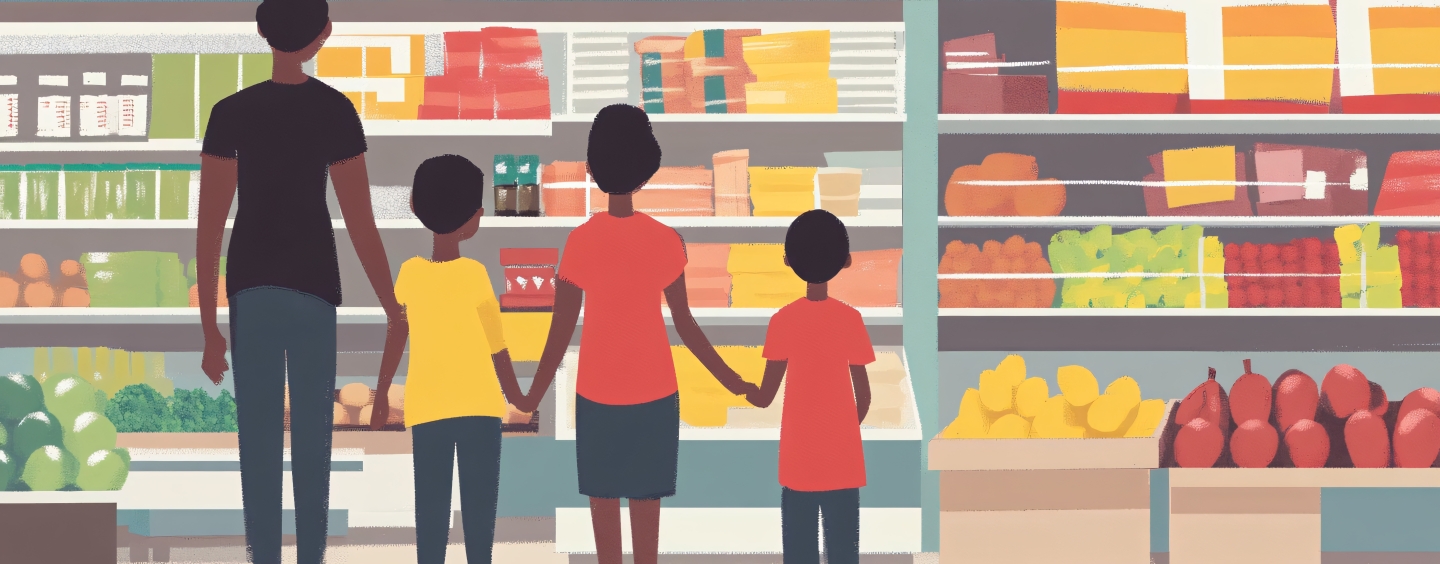How Zoning Laws Affect Both Grocery Deserts and Housing Scarcity

Outdated Zoning Laws are a primary cause for grocery deserts and housing scarcity. Read this article to learn more about how restrictive land uses led to a scarcity in affordable and accessible housing as an outcome.
What are Zoning Laws? - Zoning in a Nutshell
Zoning is the process by which cities determine appropriate land uses, deciding what type of structures can be built on designated properties, the general use of the buildings, and limit the size, shape, and scale of establishments.
Grocery deserts and housing scarcity are a direct result of zoning laws, which were created to enforce separation of land uses and limit development density. Ultimately preventing communities, most prominently communities of color, and lower-income folks, to access affordable and easily accessible food and shelter.
Grocery Deserts - Zoning’s Unintentional / Intentional Creation
In present-day world, the cost of food continues to increase, leaving individuals constantly tailoring their budgets to keep up with the flow of growing living costs. Food security is a significant social issue across the nation, prominent within communities of color and low-income households, that plays a significant role on individuals mental health and physical well-being.
Ever thought of growing your own produce in your yard to save money on groceries? Ever wished you had a community garden where you could access vegetables and food staples? What if I told you zoning laws prohibit growing your own produce? Many zoning laws make it incredibly challenging to grow food within city limits. Throughout decades, restrictions have been lifted, and permits have been allowed, but there are still regions in the nation that continue to face harsh restrictions.
In suburban communities, there are regulations that command homeowners to leave their front yards as ornamental, keeping their yards looking tidy and aesthetic, leaving no room for harvesting produce. Despite the perception of abundance, residents living in suburbs face food insecurities just like the many residents in rural and urban regions in the nation do. However, here in San Francisco, zoning laws generally allow for residents to grow their own produce in their yard as long as residents follow restrictions like heights or sidewalk interference.
On our campus, grocery stores, libraries, coffee shops, and shopping outlets are all within walking distance. Now, if you were to step off campus, observe and notice the endless parking structures, industrial establishments, and place yourself in a local home within those types of regions, you must acknowledge the fact that you would need a vehicle or utilize public transit to access fresh produce. This is a direct result of zoning laws.
Zoning laws were created in the earlier 20th century, to control urban growth and land uses. When first establishing zoning laws that was the intention, they later became grounds for racial segregation and class exclusion. These zoning laws established that lower-income communities, and communities of color, would be surrounded by small convenient stores, rather than grocery stores full of whole, healthy foods, by the usage of mechanisms like expulsive or exclusionary zoning, and redlining. Ultimately, making land investors believe that implementing establishments like chains of supermarkets in lower-income neighborhoods was hazardous and a waste since people of color were predominantly lower-income, and wouldn’t be able to afford whole foods. In all, the nation limited building corner grocery stores in an effort to prevent the development and progression of low-income neighborhoods. ⁷ ⁸
This created a lasting effect that exists today, where folks rely on local convenient stores for food access which led to poor health outcomes. Birthing economic barriers where individuals in low-income communities find it more expensive to purchase whole, healthy foods, gravitating to unhealthy foods which are more inexpensive in comparison, causing continuous systemic barriers thanks to zoning laws. ¹
Resolving Food Crisis
A few solutions to implement into the well-being of communities, is to permit urban agriculture for both personal and commercial use, in residential, commercial, and mixed-use zones. Creating a permit or policies for residential food production and harvesting can boost the health states of those who suffer from food security concerns. To add, allowing for small grocery stores and food markets to be developed and operated by community members or residential families in all zones and regions, can lead to healthier, more vibrant, equalized neighborhoods. ²
The Bridge Between Zoning and Housing
In the segment of housing, zoning laws created housing scarcity by artificially limiting the amount and type of housing that can be built. Zoning rules were and are set up where they unintentionally or intentionally exclude lower-income and minority populations. Zoning laws restricted the number of residents per square feet and outlined what relationships the residents in a home could have. In San Francisco, only members of the immediate family one generation out could live together with the exception of live-in servants (San Francisco Planning Code 102.8).
Prohibiting multigenerational households, which were common among low-income folks and immigrants. Zoning laws systematically prioritized property values and higher-class neighborhoods over state and regional wide needs for housing affordability. This means that cities cared more about eliminating white and non-white association, ensuring a border between communities and class, than prioritizing housing accessibility to folks of all communities. ⁸
For example, the most prominent zoning law is the traditional single-family structure where properties can only strictly build single-family homes, reducing the supply of land that is available for new housing structures.³ These traditional zoning practices can inhibit the ability of low-income families to live in resource-rich neighborhoods, affecting folks' abilities to quality education, public services, and proximity to employment. Creating a form of exclusionary zoning, which contributes to socioeconomic divisions, inflating housing prices, decreasing access to affordability. ⁴
Acknowledging housing as a nationwide right, is needed to intervene and address the legal barriers and systemic inequalities that exist today, that continue to affect many individuals all over the nation.
Take on Housing Scarcity
In order to decrease the nation's housing shortage, communities should advocate for the state government to use their power and legal authority to intercept local policies and laws that restrict housing development. Reform begins with stronger policies the state needs to override, in order to eliminate exclusionary zoning practices and increase housing supply.
In California, Senate Bill 79, signed by Gavin Newsom preempts local zoning regulations to permit increased housing density near transit hubs. State officials and proponents assert that in focusing new development in well-connected areas, the legislation will create more homes and lower costs, making progress in tackling root causes of California housing scarcity and affordability crisis. ⁶
In Daly City, when you need a break from noise, you can take a walk around Lake Merced, enjoy the beautiful scenery and the sound of the leaves on the trees rustling against each other. Whereas in Bayview, you can take a walk to Heron’s Head Park, surrounded by industrial plants, with visible and audible pollution, surrounded by hazardous material and chemicals in the atmosphere. The key difference is that you will never cross a street in Daly City and suddenly be surrounded by manufacturing, industrial factories. Whereas, in Bayview there is no transition
from residential to industrial. A home is placed five feet away from a concrete supply factory. A direct result of zoning laws.
To conclude, zoning laws directly create and contribute to both grocery deserts and housing scarcity by enforcing separation of land uses and limiting development density. Separating residential areas from commercial ones creates cycles that suppress food and housing access.
References
1. Sustainability Directory. How Does Zoning Affect Food Affordability? Lifestyle Sustainability Directory. September 13, 2025 https://lifestyle.sustainability-directory.com/question/how-does-zoning…
2. Hervey G. American Planning Association, 4 Zoning Changes That Boost Food Security. Planning. August 5, 2021. https://www.planning.org/planning/2021/summer/4-zoning-changes-that-boo…
3. Addressing Challenges to Affordable Housing in Land Use Law. Harvard Law Review. February 2022. https://harvardlawreview.org/print/vol-135/addressing-challenges-to-aff…
4. Hanley A. Rethinking Zoning to Increase Affordable Housing. J. Hous Community Dev. December 22, 2023. https://www.nahro.org/journal_article/rethinking-zoning-to-increase-aff…
5. Min L. Faxi Y. Historical Redlining and Food Environments: A Study of 102 Urban Areas in the United States. ScienceDirect. March 21, 2022. https://www.sciencedirect.com/science/article/abs/pii/S1353829222000363
6. California State Senate. Governor Newsom Signs Senator Wiener's Landmark Law to Build More Homes Near Public Transit. Senate District 11 website. October 10, 2025. https://sd11.senate.ca.gov/news/governor-newsom-signs-senator-wieners-l….
Tags



